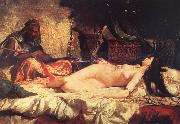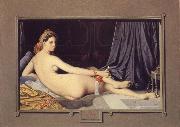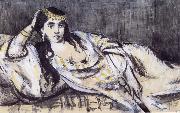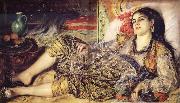
Oil On
Canvas, Real Flavor of Old Masters
|
Mariano Fortuny y Marsal
|
|||
|
|
|||
| 1838-1874 Spanish Mariano Fortuny y Marsal Gallery He was born in Reus, a town near Taragona in the autonomous community of Catalonia in Spain. His father died when he was an infant, his mother by age 12, thus Mariano was raised by his grandfather, a cabinet-maker. His grandfather taught him to make wax figurines. At the age of 9, at a public competition in his town a local patron, Domingo Soberno, encouraged further study. At the age of 14 years he moved to Barcelona with his grandfather. A sculptor, Domingo Taleru, secured him a pension of to allow him to attend the Academy of Barcelona. There he studied for four years under Claudio Lorenzale, and in March of 1857 he gained a scholarship that entitled him to two years of studies in Rome starting in 1858. There he studied drawing and grand manner styles. In 1859, he was called by the Spanish government to depict the campaigns of the Spanish-Moroccan War. The expedition lasted for only about six months, and he returned to Spain in the summer of 1860. The battle of Tetuan by Mariano Fortuny (1863-73)Since the days of Velazquez, there had been a tradition in Spain of memorializing battles and victories in paint; and on the basis of his experiences, Fortuny was commissioned by the city of Barcelona to paint a large canvas diorama of the capture of the camps of Muley-el-Abbas and Muley-el-Hamed by the Spanish army. He began his composition of The battle of Tetuan on a canvas fifteen metres long; but though it worked on and off on it during the next decade, he never finished it. The greater influence of this travel on Fortuny was his subsequent fascination with the exotic themes of the world of Morocco, painting both individuals and imagined court scenes. He visited Paris in 1868 and shortly afterwards married Cecilia de Madrazo, the daughter of Federico Madrazo, who would become curator of the Prado Museum in Madrid. Together, they had a son, Mariano Fortuny y Madrazo, who became a well-known fashion and tapestry designer. Another visit to Paris in 1870 was followed by a two years' stay at Granada, but then he returned to Rome, where he died somewhat suddenly on the 21st of November 1874 from an attack of tertian ague, or malaria , contracted while painting in the open air at Naples and Portici in the summer of 1874. Fortuny paintings are colorful, with a vivacious iridescent brushstroke, that at times recalls the softness of Rococo painting but also anticipates impressionist brushwork, Fortuny??s recollection of Morocco is not a costume ball, but a fierce, realistic portrait which includes bare-chested warriors. Richard Muther states: ??his marvellously sensitive eye ?? discerned the stalls of Moorish carpet-sellers, with little figures swarming, and the rich display of woven stuffs of the East; the weary attitude of old Arabs sitting in the sun; the sombre, brooding faces of strange snake-charmers and magicians. This is no Parisian East??every one here speaks Arabic??. Fortuny often painted scenes where contemporary life had still not shaken off the epaulets and decorations of ancient traditions such a the ????Burial of a matador???? and couples signing marriage contracts (La Vicaria). Each has the dazzle of bric-a-brac [1]ornament, but as in his painting of the ????Judgement of the model????, that painterly decorative air of Rococo and Romanticism was fading into academicism and left to confront the naked reality of the represented object. He inherited Goya??s eye for the paradox of ceremony and reality. | |||
|
|
|||
|
|
Odalisque new12/Mariano Fortuny y Marsal-932433.jpg Painting ID:: 40005 Visit European Gallery |
mk155 1861 Oil on card 56.8x81cm | |
Height Width |
INS/CM |
||
|
X |
|
||
|
|
|||
|
Jean Auguste Dominique Ingres
|
|||
|
|
|||
| J. A. D. Ingres (1780-1867) was born in Montauban on August 29, 1780, the son of an unsuccessful sculptor and painter. French painter. He was the last grand champion of the French classical tradition of history painting. He was traditionally presented as the opposing force to Delacroix in the early 19th-century confrontation of Neo-classicism and Romanticism, but subsequent assessment has shown the degree to which Ingres, like Neo-classicism, is a manifestation of the Romantic spirit permeating the age. The chronology of Ingres's work is complicated by his obsessive perfectionism, which resulted in multiple versions of a subject and revisions of the original. For this reason, all works cited in this article are identified by catalogue. | |||
|
|
|||
|
|
Odalisque new12/Jean Auguste Dominique Ingres-996865.jpg Painting ID:: 40035 Visit European Gallery |
mk155 between 1824 and 1834 Oil on canvas 44.2x61.5cm | |
Height Width |
INS/CM |
||
|
X |
|
||
|
|
|||
|
Edouard Manet
|
|||
|
|
|||
| French Realist/Impressionist Painter, 1832-1883 The roughly painted style and photographic lighting in these works was seen as specifically modern, and as a challenge to the Renaissance works Manet copied or used as source material. His work is considered 'early modern', partially because of the black outlining of figures, which draws attention to the surface of the picture plane and the material quality of paint. He became friends with the Impressionists Edgar Degas, Claude Monet, Pierre-Auguste Renoir, Alfred Sisley, Paul Cezanne, and Camille Pissarro, through another painter, Berthe Morisot, who was a member of the group and drew him into their activities. The grand niece of the painter Jean-Honor?? Fragonard, Morisot's paintings first had been accepted in the Salon de Paris in 1864 and she continued to show in the salon for ten years. Manet became the friend and colleague of Berthe Morisot in 1868. She is credited with convincing Manet to attempt plein air painting, which she had been practicing since she had been introduced to it by another friend of hers, Camille Corot. They had a reciprocating relationship and Manet incorporated some of her techniques into his paintings. In 1874, she became his sister-in-law when she married his brother, Eugene. Self-portrait with palette, 1879Unlike the core Impressionist group, Manet maintained that modern artists should seek to exhibit at the Paris Salon rather than abandon it in favor of independent exhibitions. Nevertheless, when Manet was excluded from the International exhibition of 1867, he set up his own exhibition. His mother worried that he would waste all his inheritance on this project, which was enormously expensive. While the exhibition earned poor reviews from the major critics, it also provided his first contacts with several future Impressionist painters, including Degas. Although his own work influenced and anticipated the Impressionist style, he resisted involvement in Impressionist exhibitions, partly because he did not wish to be seen as the representative of a group identity, and partly because he preferred to exhibit at the Salon. Eva Gonzal??s was his only formal student. He was influenced by the Impressionists, especially Monet and Morisot. Their influence is seen in Manet's use of lighter colors, but he retained his distinctive use of black, uncharacteristic of Impressionist painting. He painted many outdoor (plein air) pieces, but always returned to what he considered the serious work of the studio. Manet enjoyed a close friendship with composer Emmanuel Chabrier, painting two portraits of him; the musician owned 14 of Manet's paintings and dedicated his Impromptu to Manet's wife. Throughout his life, although resisted by art critics, Manet could number as his champions Emile Zola, who supported him publicly in the press, Stephane Mallarme, and Charles Baudelaire, who challenged him to depict life as it was. Manet, in turn, drew or painted each of them. | |||
|
|
|||
|
|
Odalisque new12/Edouard Manet-592866.jpg Painting ID:: 40092 Visit European Gallery |
mk155 between 1862 and 1866 Watercolor Indian ink gouach highlights 13x20cm | |
Height Width |
INS/CM |
||
|
X |
|
||
|
|
|||
|
Pierre-Auguste Renoir
|
|||
|
|
|||
| French Impressionist Painter, 1841-1919 French painter, printmaker and sculptor. He was one of the founders and leading exponents of IMPRESSIONISM from the late 1860s, producing some of the movement's most famous images of carefree leisure. He broke with his Impressionist colleagues to exhibit at the Salon from 1878, and from c. 1884 he adopted a more linear style indebted to the Old Masters. His critical reputation has suffered from the many minor works he produced during his later years. | |||
|
|
|||
|
|
Odalisque new12/Pierre-Auguste Renoir-855722.jpg Painting ID:: 40094 Visit European Gallery |
mk155 1870 Oil on canvas 69.2x122.6cm | |
Height Width |
INS/CM |
||
|
X |
|
||
|
|
|||










